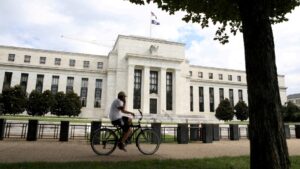Navigating Interest Rates: What You Need to Know Right Now
In today’s unpredictable economic climate, understanding interest rates is more critical than ever. With recent reports highlighting a stronger job market and persistent inflation, the Federal Reserve is expected to maintain the current interest rates. Despite calls for lower rates, particularly from figures like former President Donald Trump, central banks operate independently, prioritizing long-term economic stability over political pressures.
The Current Landscape
The Federal Reserve’s actions, particularly concerning the federal funds rate—the benchmark for many loans—directly influence everyday borrowing costs. While banks charge one another for overnight lending based on this rate, consumers feel the ripple effects in their credit card rates, mortgage loans, and more.
Why Rates Matter
High interest rates can tighten budgets, affecting everything from mortgages to car loans. Amid ongoing concerns about tariffs and trade wars—which often lead to price increases—the Fed is cautious in its decision-making. Industry experts like Greg McBride from Bankrate emphasize that the current economic data suggests a stable but uncertain environment, leading the Fed to likely maintain its current stance for the near future.
What to Expect
Financial markets are widely anticipating rate cuts later in the year, possibly as early as July. This could lead to decreased borrowing costs across various consumer loans, making it more feasible for individuals to tap into lower-cost financing options—a potential silver lining for many households.
Impact on Personal Finance
Understanding how these dynamics affect your personal finances can empower you to make informed decisions. Here’s a deeper dive into how interest rates play out in key areas of personal finance.
1. Credit Cards
Most credit cards carry variable interest rates tied to the Fed’s adjustments. Currently, average APRs hover around 20%, significantly impacting those with existing debt. Many consumers are grappling with record-high credit card balances, making it vital to seek solutions for high-cost debt.
Tip: Consider transferring high-interest balances to cards with lower APRs or creating a debt repayment strategy to minimize interest payments.
2. Mortgages
Mortgage rates, though somewhat insulated from day-to-day Fed decisions, are influenced by overall economic conditions. A 30-year fixed-rate mortgage averages around 6.81%, and while this is a slight decrease, it still poses challenges for buyers in a competitive housing market.
Tip: If you’re considering buying a home, lock in rates early or explore options like adjustable-rate mortgages (ARMs) if you plan to move or refinance in the near future.
3. Auto Loans
Auto loan interest rates remain relatively stable but have increased due to rising vehicle prices and tariffs. Currently, the average rate for a five-year new car loan is about 7.33%, making it crucial for potential buyers to plan their purchases wisely.
Tip: Shop around and compare rates from different lenders; even a small percentage difference can lead to significant savings over the life of the loan.
4. Student Loans
For student loans, rates are typically fixed, offering some protection against fluctuations. The new rates for the 2024-2025 academic year are set to rise slightly. For existing borrowers, the focus should shift to payment strategies, especially as federal forgiveness options continue to evolve.
Tip: Revisit your repayment plan and explore income-driven repayment options if you’re feeling the burden of high student debt.
5. Savings Accounts
On a positive note, top-yielding online savings accounts are currently offering yields of up to 4.5%. While the Fed’s actions don’t directly dictate deposit rates, they are closely correlated.
Tip: Maximize your savings by taking advantage of high-interest accounts to ride out periods of uncertainty.
Final Thoughts
In times of economic uncertainty, prioritizing financial resilience becomes paramount. Building emergency savings and reducing high-interest debt can serve as powerful protective measures against unexpected financial challenges.
At Extreme Investor Network, we’re committed to providing you with actionable insights and strategies to navigate the complex world of personal finance. Stay connected with us for ongoing updates and expert advice that will help you take control of your financial future.
For more personalized financial insights tailored to your unique situation, don’t hesitate to reach out to our team!

